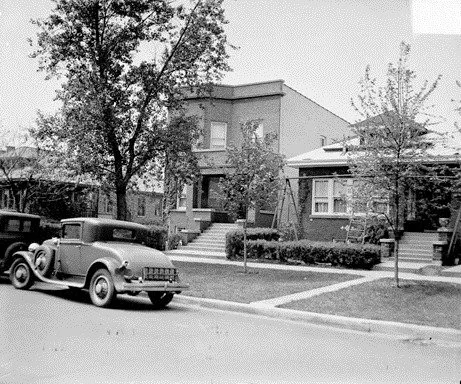Al Capone’s Covenant
By Ben Miller
In the late 1920s, covenant fever swept the South Side of Chicago. As the city’s Black population boomed, white residents mobilized to prevent their neighborhoods from becoming integrated. Realtors, businesses, and community groups worked to convince homeowners to sign agreements that barred Black families from ever buying or renting their properties. In Park Manor, nine miles south of the Loop, covenant organizers conscripted a surprising ally: the city’s most infamous gangster, Al Capone.
When he was not hiding from police or his gangland rivals, Capone lived at 7244 Prairie Ave, a modest home in the heart of Park Manor. Capone’s neighbors included a mix of longtime Irish and German residents alongside first-generation Americans like himself (mostly from Italy and Sweden). Park Manorites had no common nationality, but they shared a commitment to keeping their neighborhood racially homogenous. Like most white Chicagoans at the time, they believed that people of different races could not live peacefully together and that any rupture in the color line would cause chaos and devastate property values. In 1927, the Park Manor Improvement Association dedicated itself to excluding Black people by covering the entire neighborhood with racial covenants. To pull it off, the association needed signatures from every property owner they could find, including the denizen of 7244 Prairie Ave.
Capone’s house at 7244 Prairie Ave, as it appeared in 1929. (Source: Wikimedia Commons)
Park Manor residents knew perfectly well who owned the home—and not just because of the bomb-proof steel bars that guarded its windows. Capone openly listed himself as the resident of 7244 Prairie Ave in Chicago’s 1923 telephone directory. The following year, the house hosted dozens of mobsters for a lavish funeral after Capone’s brother Frank died in a shootout. Chicago police even besieged the property around Christmas in 1927, part of an effort to harass Capone into leaving town.
In fact, covenant organizers turned their attention to the 7200 block of Prairie Ave just weeks after Capone’s most infamous act: the St. Valentine’s Day massacre that killed seven of his North Side enemies on February 14, 1929. The crime made international headlines, but it did not change the calculus for the proponents of race restriction. To prevent Black migration into Park Manor, covenants needed to cover as many houses as possible. What the owners of those properties did professionally didn’t seem relevant.
On May 25, 1929, organizers arrived to collect a signature for 7244 Prairie Ave. Capone had just been jailed on a gun charge in Pennsylvania, but his mother Theresa was available to sign since the property was officially titled under her name. Theresa dutifully added the Capone home to a covenant which proclaimed that “no part of said premises shall in any manner be used or occupied directly or indirectly by any negro or negroes.” A notary public then certified her signature as real and freely given. A week later, organizers filed the covenant with the Cook County Recorder of Deeds, making it legally binding.
Theresa Capone signed the covenant twice to cover both lots that formed the Capone homestead at 7244 Prairie Ave. Below, notary William Tyler affirmed that her signature was valid.
Black Chicagoans didn’t miss the irony. An editorial in the Defender remarked bitterly that the same neighborhoods which used covenants to exclude African Americans imposed “no penalty upon white criminality.” Capone and other gangsters like Dean O’Banion lived in respectable white communities whose residents left them alone. Meanwhile, law-abiding Black citizens faced vicious discrimination “not because they are criminals or indulge in activities which bring their city and community into disrepute, but because of their racial connections.” African Americans, the paper noted, were treated like “any far-seeing social group would treat its criminals.”
Absurd as it was, the Capone family’s presence on a covenant encapsulated how white Chicagoans understood their homes and communities in the 1920s. Capone may have been a murderous bootlegger, but his criminal empire did not threaten the dreams or pocketbooks of ordinary families. Desegregation, on the other hand, loomed menacingly in a world where most white people saw race mixing as synonymous with violence and decline. This sort of racial logic survived much longer than the Park Manor covenant itself, helping sustain Chicago as one of the most segregated cities in America.
Sources:
“Another Reason for Crime,” Chicago Defender, July 7, 1928.
“Capone, Echoed by Saltis, Cries Out Desperation,” Chicago Tribune, December 27, 1927.
Document 103877098, Book 27311, Page 50-51.
Wallace Best, “Greater Grand Crossing” in Encyclopedia of Chicago, http://encyclopedia.chicagohistory.org/pages/547.html.
Tom Philpott, The Slum and the Ghetto, (New York: Oxford University Press, 1978), 198-199.

